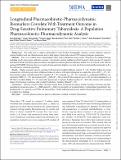Longitudinal PKPD biomarkers correlate with treatment outcome in drug sensitive pulmonary tuberculosis; a population pharmacokinetic-pharmacodynamic analysis
Abstract
Background . This study aims to explore relationships between baseline demographic covariates, plasma antibiotic exposure, sputum bacillary load, and clinical outcome data to help improve future tuberculosis (TB) treatment response predictions. Methods . Data were available from a longitudinal cohort study in Malawian drug-sensitive TB patients on standard therapy, including steady-state plasma antibiotic exposure (154 patients), sputum bacillary load (102 patients), final outcome (95 patients), and clinical details. Population pharmacokinetic and pharmacokinetic-pharmacodynamic models were developed in the software package NONMEM. Outcome data were analyzed using univariate logistic regression and Cox proportional hazard models in R, a free software for statistical computing. Results . Higher isoniazid exposure correlated with increased bacillary killing in sputum (P < .01). Bacillary killing in sputum remained fast, with later progression to biphasic decline, in patients with higher rifampicin area under the curve (AUC)0-24 (P < .01). Serial sputum colony counting negativity at month 2 (P < .05), isoniazid CMAX (P < .05), isoniazid CMAX/minimum inhibitory concentration ([MIC] P < .01), and isoniazid AUC0-24/MIC (P < .01) correlated with treatment success but not with remaining free of TB. Slower bacillary killing (P < .05) and earlier progression to biphasic bacillary decline (P < .01) both correlate with treatment failure. Posttreatment recurrence only correlated with slower bacillary killing (P < .05). Conclusions . Patterns of early bacillary clearance matter. Static measurements such as month 2 sputum conversion and pharmacokinetic parameters such as CMAX/MIC and AUC0-24/MIC were predictive of treatment failure, but modeling of quantitative longitudinal data was required to assess the risk of recurrence. Pooled individual patient data analyses from larger datasets are needed to confirm these findings.
Citation
Kloprogge , F , Mwandumba , H C , Kamdolozi , M , Banda , G , Shani , D , Corbett , E L , Kontogianni , N , Ward , S , Khoo , S H , Davies , G R & Sloan , D J 2020 , ' Longitudinal PKPD biomarkers correlate with treatment outcome in drug sensitive pulmonary tuberculosis; a population pharmacokinetic-pharmacodynamic analysis ' , Open Forum Infectious Diseases , vol. 7 , no. 7 , ofaa218 . https://doi.org/10.1093/ofid/ofaa218
Publication
Open Forum Infectious Diseases
Status
Peer reviewed
ISSN
2328-8957Type
Journal article
Description
Funding: Wellcome Trust Clinical PhD Fellowship awarded to D.S. (086757/Z/08/A). Funding for the minimum inhibitory concentration assays was provided by a grant from the British Society for Antimicrobial Chemotherapy (GA2015_036P). F.K. has conducted the research as part of his Medical Research Council fellowship (MR/P014534/1).Collections
Items in the St Andrews Research Repository are protected by copyright, with all rights reserved, unless otherwise indicated.

